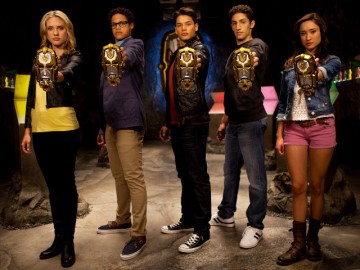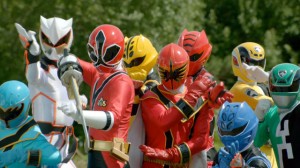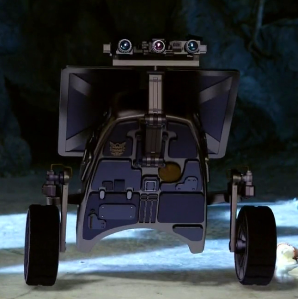EDIT: The premiere episode is available on Hulu if you’d like to see it for yourself!
Somewhere around twenty years ago, I was watching something or other on Fox when a commercial for a new show came on — and it was like nothing I’d ever seen before. Five teenagers morphing into heroes imbued with incredible power, wielding ray guns and magical weapons and giant goddamned robots against an army of evil aliens. I knew, from that first moment, that I had to see that show, and though my mother always kind of hated it, I was soon one of the biggest Power Rangers fans around. I drifted away from the franchise somewhere around Zeo, found my way back for Dino Thunder, S.P.D. and Mystic Force, dabbled in RPM, and finally came back for good only recently, sinking more money than I care to admit into toys and prop replicas and a kickass old-school Pink Ranger costume that should be here this week (and that I’ll definitely be wearing to PAX East). With the franchise back in the hands of Saban, the very people who originally adapted Kyōryū Sentai Zyuranger into Mighty Morphin’ Power Rangers, and Saban and Bandai both going all out to celebrate the unbelievable success of the franchise (seriously, how many kids’ shows have lasted two decades and come back from the dead no less than three times?), it’s never been a better time to be a fan.
If Power Rangers Samurai was a love letter to the fans, featuring the return of original supporting character Farkas “Bulk” Bulkmeier and a theme song adapted from the original Go Go Power Rangers, then Power Rangers Megaforce is a big handmade Valentine with glitter and frothy pink trim glued to a box of chocolates and delivered along with the biggest bouquet of roses you ever did see. The Power Rangers fan community was already stoked when it was revealed that Megaforce would be adapting two Super Sentai series at once: Tensou Sentai Goseiger and Kaizoku Sentai Gokaiger, the latter being Super Sentai producer Toei‘s own love letter to its fans. Gokaiger is built around the premise that all the past Super Sentai teams — all of them — fought together against a massive alien empire, ultimately losing their powers in the process. These powers are rediscovered some time later by a crew of space pirates who become heroes in their own right, tapping into the abilities of past teams to supplement their own. Every past Super Sentai team makes an appearance in some fashion, and themes from each past series are woven into the appropriate episodes of Gokaiger. No one was really expecting Saban to do anything so elaborate…but they totally are. In fact, they had Toei reshoot the Legend War scenes from Gokaiger using American Power Ranger teams just so they could weave that footage into Megaforce at some point. Lots of people, myself included, expected that the Legend War stuff wouldn’t come in until the second season, which will reportedly make full use of Gokaiger…but we were wrong. Oh so deliciously wrong.
In the first episode alone, we’re treated to images of past Ranger teams fighting together against a vast army, thanks to the new Red Ranger’s mysterious visions; the Ranger Keys (used by the Gokaigers to tap into their predecessors’ powers) on prominent display in the new command center; the new mentor, Gosei, telling the Megaforce Rangers that he was appointed Earth’s guardian by his mentor, Zordon; and a brand new hangout named Ernie’s Brain Freeze in an obvious homage to the owner of the old Angel Grove Youth Center. Plus there are callbacks to the infamous “teenagers with attitude” line from the original series and Kimberly‘s joke about refusing to become a Power Ranger because the helmet seriously messes up her hair. Like I said — big frothy Valentine with chocolates, flowers, and probably some stuff I shouldn’t spell out on a family blog.
But enough about the past. Let’s talk about the episode itself. There are SPOILERS ahead, so if you’re going to watch Megaforce at all, go find the premiere episode and then come back. For the rest of you, let me sum up.
We’re introduced right away to the aforementioned Red Ranger-to-be, Troy, who wakes from a weird dream about the past Rangers to find that he’s the only one left on his school bus and he’s going to be late for class. In short order, we’re introduced to Emma, a BMX biker with a passion for environmentalism and photography; Jake, the plucky comic relief; Noah, an obvious geek and total technophile; and Gia, a drop-dead gorgeous blonde with a brilliant mind and a whole ton of self-confidence. We get a brief glimpse into their characters thanks to the science teacher posing a thought experiment: of all the life forms on Earth, which is destined to survive the longest? Emma immediately says it’s the insects, hardy and adaptable, who will survive long after mankind has destroyed the planet. Noah immediately objects in a way that leaves me wondering if his character has Asperger’s (not that this would be a bad thing — in fact, a Ranger on the autism spectrum would be very interesting, if handled with sensitivity — but his behavioral tics beg the question), claiming that robots will become the dominant life form. Gia argues that robots aren’t alive, and Noah keeps muttering that they’re wrong, while his best friend Jake is too busy drooling over Gia to offer any further comment. Troy arrives late, and the teacher immediately pulls him into the discussion; in a revealing moment, Troy optimistically proposes that humans will outlast all other life, because if we work together, we can overcome all our problems.
But all is not well on the planet Earth, and Emma’s theory about insects is about to receive a huge shot in the arm, because the evil Admiral Malkor, leader of an army of insectoid aliens called the Warstar, is about to launch his invasion. In an underground chamber, the guardian Gosei senses this threat, and reactivates his command center, instructing his robot assistant Tensou to recruit five teenagers with the attitude necessary to fight the forces of evil. The five teenagers we’ve already met are duly teleported to the command center, where Gosei explains that they’ve been chosen to carry on the legacy of the Power Rangers and defend the planet from Malkor and his goons. Troy immediately recognizes the Ranger Keys displayed on the wall, and we get another brief glimpse of his visions of war, but he doesn’t really explain and Gosei merely says that the figures represent past teams. Gosei wastes no time in passing out colors and animals: Emma is the Pink Phoenix Ranger, Gia is the Yellow Tiger Ranger, Noah is the Blue Shark Ranger, Jake is the Black Snake Ranger, and Troy is the Red Dragon Ranger and the team’s leader. Troy immediately objects that he’s new in town and he’s only just met the others, but Gosei insists that Troy has the character necessary to lead, that he has already triumphed over adversity (which, of note, is never explained either) and he will lead his team to victory in the face of evil. The new Megaforce Rangers get their morphers and the cards necessary to operate them — more on that later — and head out into the field to bust some aliens. They acquit themselves well while still unmorphed, but ultimately have to use their Gosei Morphers (someone has an ego) when the aliens start pulling blasters and Malkor sends a tougher minion down to fight them. But once they’re morphed, the Rangers adapt to their new powers with no problems at all, and very soon the day is saved. They don’t even have to bust out the giant robots. They meet briefly with Gosei back at the command center, affirm their commitment to the Megaforce, and bump fists before uttering the catchphrase of the series: “Earth Defenders — Never Surrender!” Groan.
Okay, let’s break this down.
Things I Liked
- Gia is REALLY hot. Not just physically (though that too), but she has a smirking self-confidence, she’s tall and physically capable, and she’s clearly damn smart. I think she may be beating out Kimberly, Vida and Summer as my favorite female Ranger. Okay, no one can ever beat Kimberly, but Gia is definitely up there. It’s not hard to see why Jake is so interested in her, or why Noah points out that Gia is generally considered the hottest girl in school.
- Emma is also really hot, but more to the point, she’s extremely charismatic. She’s also obviously intelligent, and while she doesn’t have Gia’s spirit, she still has a lot of confidence all her own. She keeps a cool head and she’s creative in a fight — in the initial battle she uses the flash on her camera to help her take on multiple opponents at once, distracting some with the flash while she takes down their buddies, then cleaning up the rest. This is honestly the first time I’ve liked both of the female Rangers in any given series just as much. I almost always have a favorite, but not this time. Emma’s definitely up there with Gia kicking Vida and Summer’s asses.
- Emma and Gia together are an unstoppable combination. Their affection for one another is obvious. They’re officially acknowledged as best friends in dialogue and in the press packets Saban and Nickelodeon sent out, but I really didn’t need anyone to tell me that. It was obvious from the first moment I saw them together. Yes, I’m already shipping them. But more to the point, it’s easily one of the most compelling friendships I’ve ever seen in this franchise. You feel warm and fuzzy just watching them. It’s adorable, endearing and easily the best part of the show.
- Most of the callbacks to the previous series in the Power Rangers franchise are very well done, clever little winks that make it clear that Saban respects and loves the adult fans who are watching the show. Richard Genelle, of course, is no longer with us, and could not have reprised his role as the original Ernie, but it’s genuinely touching to see him memorialized through Ernie’s Brain Freeze. The initial exchange between Gosei and Tensou about the new team recalls the similar exchange between Zordon and Alpha 5 in a cute, playful way. And, of course, Troy’s visions are endlessly fascinating and tantalizing, and my heart felt like it was going to burst from my chest when I saw those tiny figures of all the past Ranger teams lined up along the command center’s walls.
- The special effects, especially the teleportation effect, are really nicely done.
- Last, but far from least, the writing and acting are much better than they were on Power Rangers Samurai. There are still some clumsy moments, but I can actually watch and enjoy this show as opposed to cringing my way through it just to see the pretty costumes and weapons and robots. It’s not the best show I’ve ever seen, but it’s on roughly the same level as other teen dramas, like Degrassi and South of Nowhere. It’s nice to see that Saban can produce a show of this quality. After Samurai (which was a disappointing follow-up to RPM, to say the least), I was really worried about the future of the franchise. Now my fears have been laid to rest.
Things I Disliked
- Tensou sounds like Alpha 5 and looks like Johnny Five. There is no excuse for the latter in 2013. When the highly advanced robot assistant looks less advanced than the robot assistant from the show made in 1993, you have a problem. I would have preferred to see a guy in a metal suit. At least then Tensou could have been passed off as an android.
- The basic minions — who are, I am told, called Loogies, and I would really like to know who came up with that name — are obviously guys in spandex. I don’t think I’ve seen costuming this bad since the original Putty Patrollers. Minion costumes on Power Rangers are usually cheap and of obviously poor quality for obvious reasons: you need a lot of them and the budget isn’t big enough for a hundred or so high-quality costumes on top of the special effects and stuff you’re already paying for. But this is still a new low. Honestly, the first appearance of the Loogies brought my enjoyment of this episode to a screeching halt. I got back into it again, but I’m not looking forward to that unpleasant jolt when they appear in future episodes.
- Jake and Troy are both pretty poorly defined. Jake is a comic relief jock with a crush on Gia; that’s pretty much all we get. Troy is the new kid in town with some unspecified adversity in his past. While I appreciate the attention paid to Emma and Gia’s relationship, I’d really like to know more about the other Rangers. Hopefully they’ll see some more characterization soon.
- There is no reason for the Red Ranger to be the new kid in town. It happens in a whole lot of Power Rangers series — Wild Force, SPD and Mystic Force, to name a few off the top of my head — and it just doesn’t work for me. At least in this case, Troy isn’t being promoted over experienced Rangers (as Cole was on Wild Force, and Jack was on SPD), and he even questions why he’s being appointed leader, but it’s still a little grating. Troy could easily have been friends with all the others from the outset. Jason was already part of the gang on the original show. Why couldn’t Saban do the same here?
- Early in the episode, Emma heads out into the woods to photograph the migration of the monarch butterflies, which she describes as a once in a lifetime event. No, actually, it’s a pretty regular event. I realize valid science is a lot to ask from Power Rangers, but could we please have some valid elementary school science, at the very least?
- While I’m on the subject of Emma, Gosei mentions her BMX biking as one of the skills that will make her an excellent Power Ranger. I couldn’t help but think of the BMX Bandit, and there was much snickering involved.
- The morphers. They’re big, unwieldy and used for everything. Even in the middle of battle. See, to morph, the Rangers have to feed these power cards into the things. To summon their blasters, more power cards. To summon their heavier weapons, still more power cards. To combine their weapons, power cards that turn into giant power cards. In Japan, the power cards were sold commercially, used as part of a trading card game. There are power cards on sale with the Megaforce toys here in the US, and a trading card game involving multiple Power Ranger teams to come. Obvious commercialization is obvious. The franchise has always lived and died by toy sales, so I don’t mind a certain amount of commercialization. I do mind that it takes so bloody long for the Rangers to pull out the morphers, pull the power cards from their belt pouches, insert the cards into the morphers, and activate the morphers. It eats into valuable action sequence time, and leaves me wondering why the bad guys don’t simply attack while the Rangers are fiddling with those awful things.
Things I Have Mixed Feelings About
- The color coding is back in force, even before the Rangers receive their powers. This gets a lampshade (Emma notes that pink is her favorite color), but after previous series in which the color coding was not strictly enforced, I find it jarring. That said, it definitely does feed into the nostalgia, and all the characters wear their colors well. Especially Emma with those little pink shorts and Gia with that yellow tank top. Mm.
- Similarly, the color coded personalities are back in force as well: Emma is the caring, sensitive ‘heart’ of the team. Gia is the tall, athletic borderline tomboy. Noah is the geek. Jake is the entertaining jock. Still, the personalities do work, for the most part, and Troy isn’t so readily pegged. He’s appointed leader, but doesn’t necessarily seem like someone naturally inclined to take control. His background is still a mystery — and once again, I hope we get some more clues to that mystery soon.
- The theme song. I love Go Go Power Rangers as much as anyone, and it was nice to see it reprised in Samurai, but I don’t know if I need to hear it again — even if it is pretty appropriate, given Megaforce’s naked nostalgia. After Power Rangers Zeo, the franchise started to mix the themes up a little, writing an original theme for each series. Sometimes there were callbacks — a familiar musical phrase here and there — but generally the songs were brand new. I kind of miss those days now.
Still, despite my qualms, I thoroughly enjoyed the premiere episode, and since pilot episodes are nearly always unsteady, I’m sincerely hoping that the series will only improve from here. I’m excited to see the Legend War (or whatever Megaforce ends up calling it) making an early appearance, and I can’t wait for the legacy of the past Ranger teams to make itself fully manifest. I don’t think I’ve been this excited about a new series since RPM. I can’t wait to see what happens next.
Power Rangers Rating: 4 out of 5 Power Coins. Morphinomenal.
General TV Rating: 6 out of 10. Good, even great in parts, but not spectacular.




















